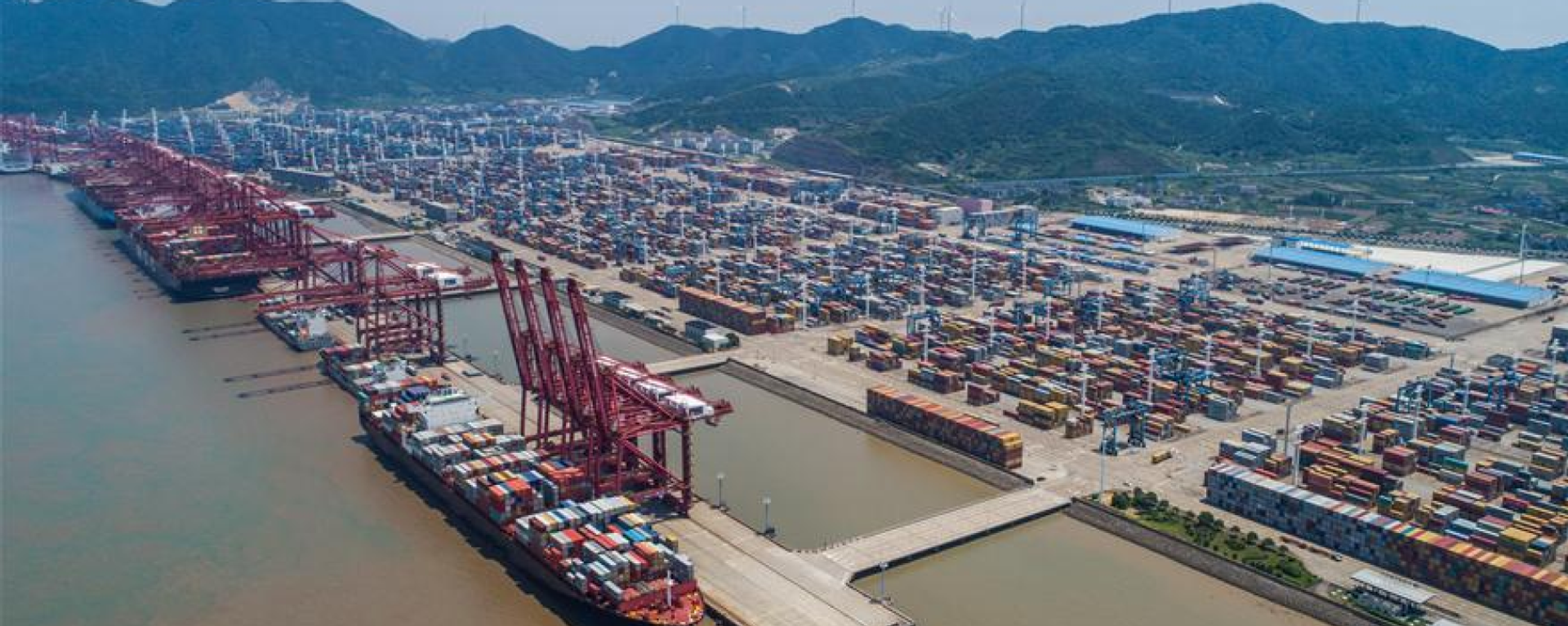https://sputniknews.in/20230411/de-coupling-from-chinese-economy-to-affect-indias-gdp-growth-expert-1507433.html
De-Coupling From Chinese Economy to Affect India's GDP Growth: Experts
De-Coupling From Chinese Economy to Affect India's GDP Growth: Experts
Sputnik India
Ongoing efforts by India to reduce reliance on Chinese imports is bound to take a toll on the overall Gross Domestic Product (GDP) growth in short to medium term, an Indian think tanker has told Sputnik.
2023-04-11T19:11+0530
2023-04-11T19:11+0530
2023-04-11T19:40+0530
long reads
india
china
narendra modi
pharmaceuticals
ladakh
us
rising economies
global supply chains
global economy
https://cdn1.img.sputniknews.in/img/07e7/04/0b/1509577_0:257:2730:1793_1920x0_80_0_0_909a9fb7e8d63d435d808c1ebe108069.jpg
India's ongoing efforts to reduce reliance on Chinese imports is bound to take a toll on the overall Gross Domestic Product (GDP) growth in the short to medium term, an Indian think tank has told Sputnik.The expert noted that a report in 2021 by the US Chamber of Commerce and Industry said that the US would lose around $1 trillion worth of production and global competitiveness if it surges ahead with de-linking its economy from China’s.In 2022, the United States ranked as China’s third-biggest trading partner with two-way trade topping $759 billion, per the General Administration of Customs (GACC). The ten-country Association of South East Asian States (ASEAN) and the EU were Beijing’s biggest trading partners.India-China trade hit a record high of $135 billion in 2022, largely driven by over $100 billion worth of imports. The trade deficit between the two countries hit $100 billion for the first time in history, with falling Indian exports to China also contributing to the deficit.“For an economy of India’s size, decoupling from China is going to be a long haul,” said Vasan.De-coupling Could Also Affect Domestic Inflation, Export RevenueGiving a macroeconomic view of the India-China trade dynamics, noted Indian economist Professor Arun Kumar underscored that cutting down on cheaper Chinese imports would mean that New Delhi will have to either source these goods from elsewhere or develop its own manufacturing base.He said that since developing own capabilities might take time, the other option of looking towards other sources with higher prices would possibly drive-up domestic inflation in certain sectors, at least for short to medium term till Indian industry is able to develop its own manufacturing expertize in these areas.Kumar also said that one could expect “reciprocal measures” from Beijing which could potentially hurt Indian exporters carrying out trade with China. He said this could adversely affect Indian export revenue, thus affecting the overall balance of payments (BoP).What Does India Import from China?According to the Indian Embassy in Beijing, machinery, power-related equipment, telecom equipment, organic chemicals and fertilizers have dominated the Chinese export basket to India over the years. India also imports plastic items, medical equipment and pharmaceutical ingredients from the PRC.On the ground in India, the market for cheaper Chinese imports in various sectors continues to attract Indian buyers, according to information from importers and industry players.Xiaomi, Vivo and Oppo consistently ranked as India's biggest smartphone brands in terms of market share in recent years, as per Counterpoint Research.In fact, several importers in New Delhi dealing in plastic, ceramics and other gift items have told Sputnik that it is “difficult” to beat Chinese manufacturers in price competitiveness and overall product finishing.Another importer said that Chinese-made statues of Indian gods and goddesses made from marble powder and ceramic attract many customers.Many of these industries fall under the Micro, Small and Medium Enterprises (MSMEs) sector, which is estimated to make up a third of India’s GDP growth and employs the second-biggest share of India's workforce after agriculture.In a bid to boost domestic manufacturing and attract foreign investment, Prime Minister Narendra Modi’s government has been providing Production Linked Incentives to industry of all sizes.The federal budget this March earmarked almost $10 billion in PLIs for manufacturing electronics, pharmaceuticals and automobile parts, among others.Why is India Worried About Rising Imports from China?Vasan explained that New Delhi’s over-reliance on Chinese imports wasn’t really a good thing and didn’t complement New Delhi foreign policy of achieving “strategic autonomy”.“Definitely, there is a need to recalibrate our supply chains and diversify to other sources. But this won’t be achieved in a mere time period of five to 10 years,” he reckoned.Vasan added that as a matter of fact, over-dependence on any one country for imports wasn’t in India’s strategic interest.He further noted that the Ladakh border standoff with China was another major qualm, noting that there are widespread concerns about exports to New Delhi funding “Chinese border aggression against us”.
https://sputniknews.in/20230411/unrealistic-for-every-firm-to-be-out-of-china-indias-finance-minister-1498810.html
https://sputniknews.in/20230404/adb-forecasts-faster-economic-growth-for-india-and-china-in-2023-1421149.html
india
china
ladakh
us
Sputnik India
feedback.hindi@sputniknews.com
+74956456601
MIA „Rossiya Segodnya“
2023
Dhairya Maheshwari
https://cdn1.img.sputniknews.in/img/07e6/0c/13/138962_0:0:641:640_100x100_80_0_0_2cb44360dbcdf6d84bf4b299cd045917.jpg
Dhairya Maheshwari
https://cdn1.img.sputniknews.in/img/07e6/0c/13/138962_0:0:641:640_100x100_80_0_0_2cb44360dbcdf6d84bf4b299cd045917.jpg
News
en_IN
Sputnik India
feedback.hindi@sputniknews.com
+74956456601
MIA „Rossiya Segodnya“
Sputnik India
feedback.hindi@sputniknews.com
+74956456601
MIA „Rossiya Segodnya“
Dhairya Maheshwari
https://cdn1.img.sputniknews.in/img/07e6/0c/13/138962_0:0:641:640_100x100_80_0_0_2cb44360dbcdf6d84bf4b299cd045917.jpg
india china trade deficit, india china trade relations, india china trade 2022, us china trade war, us china trade war
india china trade deficit, india china trade relations, india china trade 2022, us china trade war, us china trade war
De-Coupling From Chinese Economy to Affect India's GDP Growth: Experts
19:11 11.04.2023 (Updated: 19:40 11.04.2023) Exclusive
India is the fastest-growing major economy, with a projected GDP growth of 6.1% this year. New Delhi has set a target of becoming a $30 trillion economy by 2047.
India's ongoing efforts to reduce reliance on Chinese imports is bound to take a toll on the overall Gross Domestic Product (GDP) growth in the short to medium term, an Indian think tank has told Sputnik.
“There has to be a cost for India to pay as we seek to diversify our supply chains away from China. The costs may be in the form of additional costs of imports of crucial raw material inputs as well as finished products. These have direct linkages to the GDP growth,” explained Seshadri Vasan, the Director-General of Indian think tank Chennai Centre for China Studies (C3S).
The expert noted that a report in 2021 by the US Chamber of Commerce and Industry said that the US would lose around $1 trillion worth of production and global competitiveness if it surges ahead with de-linking its economy from China’s.
“In the case of India, the costs (as overall proportion of the GDP) may be bigger given that we are a $3 trillion economy. On the other hand, the US is almost a $20 trillion economy,” Vasan emphasizes.
In 2022, the United States ranked as China’s third-biggest trading partner with two-way trade topping $759 billion, per the General Administration of Customs (GACC). The ten-country Association of South East Asian States (ASEAN) and the EU were Beijing’s biggest trading partners.
India-China trade hit a record high of $135 billion in 2022, largely driven by over $100 billion worth of imports. The trade deficit between the two countries hit $100 billion for the first time in history, with falling Indian exports to China also contributing to the deficit.
“For an economy of India’s size, decoupling from China is going to be a long haul,” said Vasan.
De-coupling Could Also Affect Domestic Inflation, Export Revenue
Giving a macroeconomic view of the India-China trade dynamics, noted Indian economist Professor Arun Kumar underscored that cutting down on cheaper Chinese imports would mean that New Delhi will have to either source these goods from elsewhere or develop its own manufacturing base.
He said that since developing own capabilities might take time, the other option of looking towards other sources with higher prices would possibly drive-up domestic inflation in certain sectors, at least for short to medium term till Indian industry is able to develop its own manufacturing expertize in these areas.
Kumar also said that one could expect “reciprocal measures” from Beijing which could potentially hurt Indian exporters carrying out trade with China. He said this could adversely affect Indian export revenue, thus affecting the overall balance of payments (BoP).
“In a sense, curtailing trade with China will have a short to medium term impact on overall growth, inflation as well as balance of payments (BoP),” concluded Kumar.
What Does India Import from China?
According to the Indian Embassy in Beijing, machinery, power-related equipment, telecom equipment, organic chemicals and fertilizers have dominated the Chinese export basket to India over the years. India also imports plastic items, medical equipment and pharmaceutical ingredients from the PRC.
The embassy states that New Delhi’s ballooning trade deficit with Beijing is because of the “narrow basket” of Indian commodities and “market access impediments” for Indian agricultural products as well as other sectors.
On the ground in India, the market for cheaper Chinese imports in various sectors continues to attract Indian buyers, according to information from importers and industry players.
Xiaomi, Vivo and Oppo consistently ranked as India's biggest smartphone brands in terms of market share in recent years, as per Counterpoint Research.
In fact, several importers in New Delhi dealing in plastic, ceramics and other gift items have told Sputnik that it is “difficult” to beat Chinese manufacturers in price competitiveness and overall product finishing.
“There was a brief disruption in imports from China due to their zero-Covid policy restrictions. But now imports are picking up again,” an importer in Delhi’s Karol Bagh market said.
Another importer said that Chinese-made statues of Indian gods and goddesses made from marble powder and ceramic attract many customers.
Many of these industries fall under the Micro, Small and Medium Enterprises (MSMEs) sector, which is estimated to make up a third of India’s GDP growth and employs the second-biggest share of India's workforce after agriculture.
In a bid to boost domestic manufacturing and attract foreign investment, Prime Minister Narendra Modi’s government has been providing Production Linked Incentives to industry of all sizes.
The federal budget this March earmarked almost $10 billion in PLIs for manufacturing electronics, pharmaceuticals and automobile parts, among others.
Why is India Worried About Rising Imports from China?
Vasan explained that New Delhi’s over-reliance on Chinese imports wasn’t really a good thing and didn’t complement New Delhi foreign policy of achieving “strategic autonomy”.
“Definitely, there is a need to recalibrate our supply chains and diversify to other sources. But this won’t be achieved in a mere time period of five to 10 years,” he reckoned.
Vasan added that as a matter of fact, over-dependence on any one country for imports wasn’t in India’s strategic interest.
“De-coupling from China doesn’t mean that we will put all our eggs in the basket of Western countries,” he insisted.
He further noted that the
Ladakh border standoff with China was another major qualm, noting that there are widespread concerns about exports to New Delhi funding “Chinese border aggression against us”.
“To think of it, the $100 billion trade deficit we are running with China is more than India’s annual defense budget ($72 billion for 2023-24). That’s a serious concern,” Vasan pointed out.




